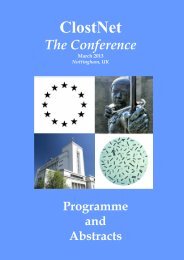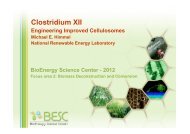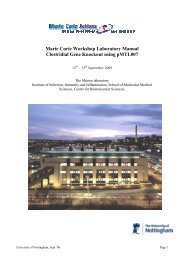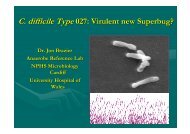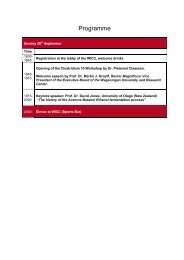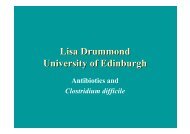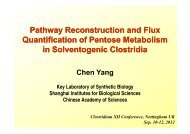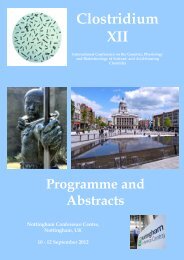abstract book - Clostridia
abstract book - Clostridia
abstract book - Clostridia
Create successful ePaper yourself
Turn your PDF publications into a flip-book with our unique Google optimized e-Paper software.
STRUCTURAL AND GENETIC CHARACTERISATION OF<br />
FLAGELLAR GLYCOSYLATION IN CLOSTRIDIUM BOTULINUM<br />
Susan M. Logan 1 , Catherine J. Paul 1,2 , Evgeny Vinogradov, David J.<br />
McNally, James A. Mullen 1 , David R. McMullin 1 , J.R. Brisson, John W.<br />
Austin 2 , John F. Kelly 1 , and Susan M. Twine 1 .<br />
1 National Research Council Institute for Biological Sciences, Ottawa,<br />
Ontario.<br />
2 Botulism Reference Laboratory, Health Canada, Ottawa,<br />
Ontario.<br />
Flagellins from Clostridium botulinum were shown to be<br />
posttranslationally modified with novel glycan moieties by top down MS<br />
analysis of purified flagellin protein from strains of unique toxin<br />
serotypes. Detailed analysis of flagellin from two strains of C. botulinum<br />
were shown to be modified in O-linkage by a novel glycan moiety of<br />
mass 417 Da. The structural characterisation of the carbohydrate<br />
moiety was completed utilising both MS and NMR and it was shown to<br />
be a novel legionaminic acid derivative. ETD-MS and ETD-cidMS was<br />
successfully utilised to map the 7 sites of O-linked glycosylation<br />
eliminating the need for chemical derivatisation of tryptic peptides prior<br />
to analysis. Marker ions for novel glycans as well as a unique C<br />
terminal flagellin peptide marker ion were identified in a top down<br />
analysis of the intact protein. These ions have the potential to be<br />
utilised for rapid detection and discrimination of C.botulinum cells and<br />
for botulinum neurotoxin (BoNT) contamination. This is the first report of<br />
glycosylation of Gram positive flagellar proteins with the “sialic acid like”<br />
nonulosonate sugar, legionaminic acid. Bioinformatic analysis of<br />
available C. botulinum genomes identified a flagellar glycosylation<br />
island containing homologs of genes recently identified in<br />
Campylobacter coli which have been shown to be responsible for the<br />
biosynthesis of legionaminic acid derivatives.<br />
41



